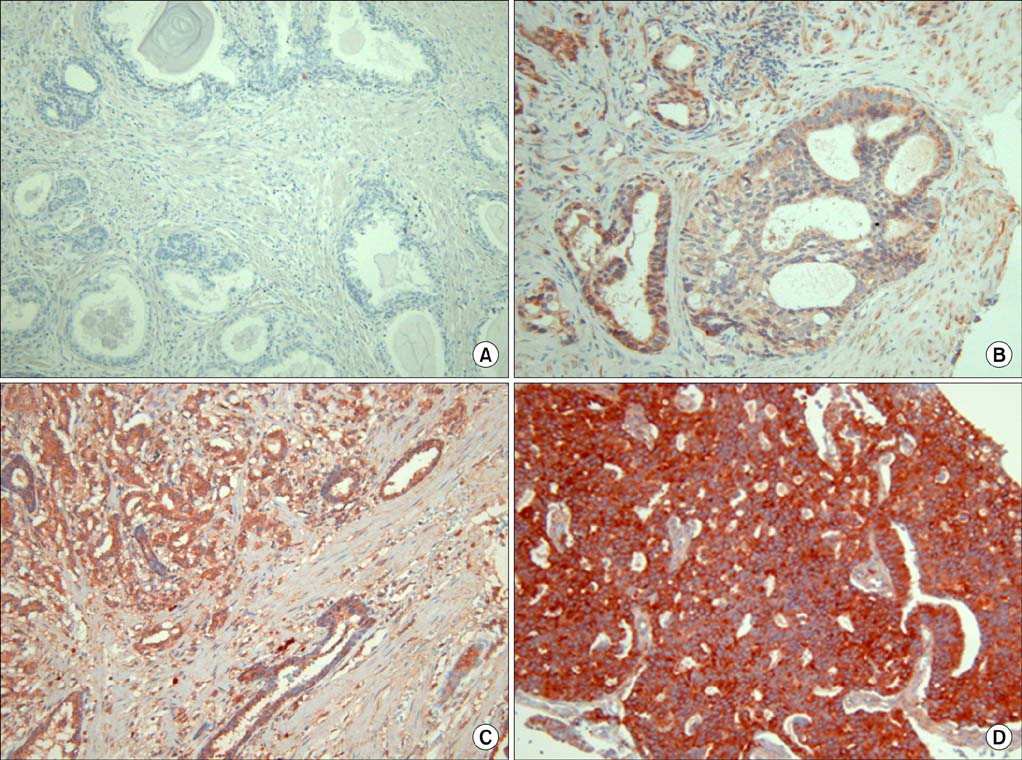Korean J Urol.
2010 Jul;51(7):456-462.
Significance of S100A2 and S100A4 Expression in the Progression of Prostate Adenocarcinoma
- Affiliations
-
- 1Department of Urology, Chung-Ang University College of Medicine, Seoul, Korea. kthlmk@hanafos.com
- 2Department of Pathology, Chung-Ang University College of Medicine, Seoul, Korea.
Abstract
- PURPOSE
The aim of this study was to investigate the expression pattern of calcium-binding proteins S100A2 and S100A4. We also sought to determine the prognostic value of these markers for patients with prostate adenocarcinoma.
MATERIALS AND METHODS
Immunohistochemical staining was performed to detect S100A2 and S100A4 expression in 26 tissue samples obtained during transurethral resection from patients with benign prostatic hyperplasia (BPH) and in 67 tissue samples obtained during prostate biopsy and radical prostatectomy from patients with prostate carcinoma. The immunoreactivity of these proteins was stratified on a scale of 0 to 3 and was correlated with the pathologic features of prostate adenocarcinoma.
RESULTS
High expression of S100A2 was observed in the tissue of patients with BPH, whereas low or no expression was observed in prostate cancer (CaP) cells. The protein level of S100A4 was significantly higher in CaP than in BPH cells. The higher level of S100A4 observed in CaP tissue correlated with increasing tumor grade.
CONCLUSIONS
Decreased expression of S100A2 and increased expression of S100A4 may be important in the progression of CaP. This finding could aid in identifying aggressive CaP. The simultaneous analysis of S100A2 and S100A4 expression in prostate tissues may be a useful prognostic marker for CaP.
MeSH Terms
Figure
Reference
-
1. Jemal A, Siegel R, Ward E, Murray T, Xu J, Smigal C, et al. Cancer statistics, 2006. CA Cancer J Clin. 2006. 56:106–130.2. Ministry for Health, Welfare and Family Affairs. Annual report of cancer incidence (2005) and survival (1993-2005) in Korea. 2008. Seoul: The Ministry.3. Klein EA, Thompson IM. Update on chemoprevention of prostate cancer. Curr Opin Urol. 2004. 14:143–149.4. Saleem M, Adhami VM, Zhong W, Longley BJ, Lin CY, Dickson RB, et al. A novel biomarker for staging human prostate adenocarcinoma: overexpression of matriptase with concomitant loss of its inhibitor, hepatocyte growth factor activator inhibitor-1. Cancer Epidemiol Biomarkers Prev. 2006. 15:217–227.5. Ilg EC, Schäfer BW, Heizmann CW. Expression pattern of S100 calcium-binding proteins in human tumors. Int J Cancer. 1996. 68:325–332.6. Heizmann CW. The multifunctional S100 protein family. Methods Mol Biol. 2002. 172:69–80.7. Donato R. S100: a multigenic family of calcium-modulated proteins of the EF-hand type with intracellular and extracellular functional roles. Int J Biochem Cell Biol. 2001. 33:637–668.8. Lee SW, Tomasetto C, Swisshelm K, Keyomarsi K, Sager R. Down-regulation of a member of the S100 gene family in mammary carcinoma cells and reexpression by azadeoxycytidine treatment. Proc Natl Acad Sci U S A. 1992. 89:2504–2508.9. Liu D, Rudland PS, Sibson DR, Platt-Higgins A, Barraclough R. Expression of calcium-binding protein S100A2 in breast lesions. Br J Cancer. 2000. 83:1473–1479.10. Maelandsmo GM, Florenes VA, Mellingsaeter T, Hovig E, Kerbel RS, Fodstad O. Differential expression patterns of S100A2, S100A4 and S100A6 during progression of human malignant melanoma. Int J Cancer. 1997. 74:464–469.11. Nagy N, Hoyaux D, Gielen I, Schafer BW, Pochet R, Heizmann CW, et al. The Ca2+-binding S100A2 protein is differentially expressed in epithelial tissue of glandular or squamous origin. Histol Histopathol. 2002. 17:123–130.12. Feng G, Xu X, Youssef EM, Lotan R. Diminished expression of S100A2, a putative tumor suppressor, at early stage of human lung carcinogenesis. Cancer Res. 2001. 61:7999–8004.13. Bronckart Y, Decaestecker C, Nagy N, Harper L, Schafer BW, Salmon I, et al. Development and progression of malignancy in human colon tissues are correlated with expression of specific Ca(2+)-binding S100 proteins. Histol Histopathol. 2001. 16:707–712.14. Lauriola L, Michetti F, Maggiano N, Galli J, Cadoni G, Schafer BW, et al. Prognostic significance of the Ca(2+) binding protein S100A2 in laryngeal squamous-cell carcinoma. Int J Cancer. 2000. 89:345–349.15. Sherbet GV, Lakshmi MS. S100A4 (MTS1) calcium binding protein in cancer growth, invasion and metastasis. Anticancer Res. 1998. 18:2415–2421.16. Grigorian MS, Tulchinsky EM, Zain S, Ebralidze AK, Kramerov DA, Kriajevska MV, et al. The mts1 gene and control of tumor metastasis. Gene. 1993. 135:229–238.17. Taylor S, Herrington S, Prime W, Rudland PS, Barraclough R. S100A4 (p9Ka) protein in colon carcinoma and liver metastases: association with carcinoma cells and T-lymphocytes. Br J Cancer. 2002. 86:409–416.18. Garrett SC, Varney KM, Weber DJ, Bresnick AR. S100A4, a mediator of metastasis. J Biol Chem. 2006. 281:677–680.19. Schafer BW, Heizmann CW. The S100 family of EF-hand calcium-binding proteins: functions and pathology. Trends Biochem Sci. 1996. 21:134–140.20. Moore BW. A soluble protein characteristic of the nervous system. Biochem Biophys Res Commun. 1965. 19:739–744.21. Sun Y. Identification and characterization of genes responsive to apoptosis: application of DNA chip technology and mRNA differential display. Histol Histopathol. 2000. 15:1271–1284.22. Tan M, Heizmann CW, Guan K, Schafer BW, Sun Y. Transcriptional activation of the human S100A2 promoter by wild-type p53. FEBS Lett. 1999. 445:265–268.23. Nagy N, Brenner C, Markadieu N, Chaboteaux C, Camby I, Schafer BW, et al. S100A2, a putative tumor suppressor gene, regulates in vitro squamous cell carcinoma migration. Lab Invest. 2001. 81:599–612.24. Barraclough R. Calcium-binding protein S100A4 in health and disease. Biochim Biophys Acta. 1998. 1448:190–199.25. Rudland PS, Platt-Higgins A, Renshaw C, West CR, Winstanley JH, Robertson L, et al. Prognostic significance of the metastasis-inducing protein S100A4 (p9Ka) in human breast cancer. Cancer Res. 2000. 60:1595–1603.26. Takenaga K, Nakanishi H, Wada K, Suzuki M, Matsuzaki O, Matsuura A, et al. Increased expression of S100A4, a metastasis-associated gene, in human colorectal adenocarcinomas. Clin Cancer Res. 1997. 3:2309–2316.
- Full Text Links
- Actions
-
Cited
- CITED
-
- Close
- Share
- Similar articles
-
- Expression of S100A4 and S100A2 is Associated with Clinicopathologic Features in Papillary Thyroid Carcinoma
- Expression of Periostin and S100A2- S100A4-Calcium Binding Proteins mRNA in Human Gingival Fibroblasts and Periodontal Ligament Fibroblasts
- Clinicopathological Significance of S100A4 Expression in Non-small Cell Lung Carcinomas
- Characterization of the Monoclonal Antibody Specific to Human S100A2 Protein
- Correlation between S100A4 and COX2 Overexpression and Invasiveness of Papillary Thyroid Carcinoma





